Axillary Digital Traction Maneuver: Shoulder Dystocia Management
- 1. Department of Family and Community Medicine, Wake Forest School of Medicine, USA
- 2. Maternal and Fetal Medicine, Carolina Medical Center Women’s Institute, USA
Abstract
The axillary digital traction maneuver to relieve shoulder dystocia is a maneuver that was mentioned in medical literature as early as the 17th century by a midwife. It has appeared in a few recent publications as an option to address complicated shoulder dystocia and was added to the list of approved maneuvers in the Advanced Life Support in Obstetrics course (ALSO) in 2013. Unfortunately, the axillary digital traction maneuver has not yet become a standard part of traditional management. Resolving the shoulder dystocia by digital traction to the posterior or anterior axilla, or both, can successfully relieve shoulder impaction. Digital axillary traction can result in shortened head to body delivery time with minimal maternal and newborn morbidity, when chosen as an early attempt to relieve the shoulders during delivery. Three cases featuring shoulder dystocia are described in this article. In these cases, these of McRoberts Maneuver accompanied by suprapubic pressure with Rubin I Maneuver were unsuccessful prior to the use of axillar digital traction which resulted in delivery. Consideration of implementing axillary traction maneuver in modern clinical practice as a viable management option for shoulder dystocia ought to be considered.
Keywords
- Axillary digital traction maneuver
- Sling
- Shoulder dystocia
Citation
Namak S, Beck K, Mertz H, Lord R (2016) Axillary Digital Traction Maneuver: Shoulder Dystocia Management. J Family Med Community Health 3(4): 1086.
ABBREVIATIONS
ACOG: American College of Obstetrics and Gynecology; ALSO: Advanced Life Support in Obstetrics; BMI: Body Mass Index; BPI: Brachial Plexus Injury; GTT: Glucose Tolerance Test; PAST: Posterior Axillary Sling Traction; RCOG: Royal College of Obstetricians & Gynaecologists
INTRODUCTION
Shoulder dystocia is an obstetric emergency occurring in about 2% of vaginal deliveries and while there are sometimes identifiable risk factors, most cases occur unpredictably and are unpreventable [1]. The time spent resolving the dystocia and the stress from outside forces applied to the infant to relieve the shoulder dystocia are key factors in determining newborn morbidity and mortality. The most common cause of morbidity is brachial plexus injury (BPI). Mortality is mainly due to fetal acidosis which is directly related to the time it takes to resolve the dystocia. Maneuvering around the infant in limited pelvic dimensions can be time consuming and thus having options to relieve a shoulder dystocia rapidly is critical.
The American College of Obstetrics and Gynecology (ACOG) recommends the McRobert’s Maneuver as the initial method to resolve shoulder dystocia [2]. The use of rotational maneuvers or delivery of the posterior shoulder is considered when McRobert’s is unsuccessful. In addition, the Royal College of Obstetricians & Gynaecologists (RCOG) also recommends the McRobert’s Maneuver as the first line approach since it is successful in 90% of cases and has a low complication rate [2,3]. Both ACOG and RCOG recommend that suprapubic pressure be used separately or in conjunction with McRobert’s Maneuver [2,3]. The other maneuvers include the all-four position, (mentioned in RCOG), or internal manipulation to include delivery of the posterior arm and internal rotation (mentioned by both) both ACOG and RCOG) [2,3].
Management of shoulder dystocia is initiated with placing the head of the bed flat, the implementation of McRobert’s Maneuverac companied with or followed by suprapubic pressure can resolve shoulder dystocia in 40 to 50% of cases [4,5]. When unsuccessful, a series of other maneuvers can be carried out until successful delivery of the infant vaginally or by cesarean section occurs. The maneuvers that are currently utilized include the Rubin I and II, the Woodscrew, Reverse Woodscrew, and Gaskin Maneuver [1]. Posterior arm delivery can also relieve shoulder dystocia and has been recommended as an earlier maneuver in the shoulder dystocia management [6]. The maneuver using axillary digital traction should also be considered as a potential method of expediting the delivery of the infant. This man ever while easy to perform is not routinely taught in clinical practice. The axillary digital traction technique is simple to demonstrate and entails the use of only with two fingers rather than the whole hand requiring less room in the pelvis to accomplish. For these reasons, digital axillary traction may be easier to perform in some situations.
CASE PRESENTATIONS
Case #1
A 34 year old black female (G3P1011) at 40.0 weeks estimated gestation age had prenatal basal metabolic index (BMI) of 24.5 Kg/m2 and a 50 pound weight gain during her antepartum period. Her 1-hour Glucose Tolerance Test (GTT) was 146 mg/ dl and the 3-hour GTT was normal. The patient presented in spontaneous active labor and received combined spinal epidural analgesia shortly after admission. The first stage of labor lasted 4 hours 39 min and her second stage of labor lasted only 6 minutes. The fetal vertex delivered in a straight occiput anterior position without restitution, no nuchal cord was identified on exam, and shoulder dystocia was diagnosed. The head of bed was put down and the McRobert’s Maneuver accompanied with suprapubic pressure was performed followed by Rubin I with neither resulting in delivery. Delivery of the posterior shoulder was accomplished using posterior digital axillary traction until the posterior arm was midway outside the perineum. This was followed by the delivery of the anterior shoulder by applying the same axillary digital traction maneuver to the anterior axilla. With both shoulders released, the rest of the body followed. The infant was a male weighing 8 pounds 6.7 ounces (3820 grams) with an Apgar score of 7at one minute and 9at five minutes. The infant required only blow by O2, tactile stimulation, and bulb suction. A mild Erbs Palsy of the anterior shoulder was noted on initial exam and started improving after 15 minutes. A second degree perineal tear was sutured. The time from delivery of head to body was 60 seconds.
Case #2
A 23 year old black female (G3P1011) at 40.1 weeks gestation had a prenatal BMI of 23.84 Kg/m2 and a weight gain of 21 pounds during her antepartum period. Her 1-hour GTT was 88 mg/dl. She presented in active labor and received an epidural for analgesia with her first stage lasting 5 hours. Her second stage lasted 17 minutes after which she began delivering a live male in a straight occiput anterior position with a “turtle sign”, a loose nuchal cord, and thin meconium. A shoulder dystocia was diagnosed. Traction was applied to the head twice without successful delivery of the anterior shoulder. The posterior shoulder was delivered by straight upward digital axillary traction until the arm was midway outside the perineum. Then attention to deliver the anterior shoulder by attempting McRobert’s maneuver accompanied by suprapubic pressure with Rubin I maneuvers without success. The next step was an attempt to rotate the already delivered posterior shoulder to the anterior position with the anterior shoulder now in the posterior position. Delivery of the anterior shoulder, now in a posterior position, was accomplished using digital axillary traction followed by successful delivery of the fetal body. The birth weight was 8Ibs 6.4 ounces (3810 grams) with Apgar scores of 8at one minute and 9at five minutes. No maternal complications. The time from delivery of head to body was 35 seconds.
Case #3
A 32 year old black female (G4P2012) presented in labor at 39.2 weeks gestation by a third trimester ultrasound. Her first delivery was a vaginal assisted forceps delivery of an 8 pound 14 ounce newborn and her second delivery was an uneventful spontaneous vaginal delivery of an 8 pound newborn. Her antepartum period in this pregnancy included late entry to care at 23 weeks gestation had a BMI of 26 Kg/m2 with a total weight gain of 40 pounds compared to her pre-pregnancy weight. She was positive for Group B streptococci and received adequate prophylaxis with two doses of penicillin. Her first stage of labor lasted for 12 hours; she received epidural analgesia and required augmentation with Pitocin. During the second stage of labor, the patient had multiple variable decelerations with pushing. The head was delivered in a left occiput anterior position with retraction noted and a shoulder dystocia called. Head traction was attempted three times without success. The head of the bed was then dropped and McRobert’s Maneuver accompanied by suprapubic pressure, and then Rubin I Maneuver were used without relief of the dystocia. The author examined the amount of the descent of the posterior shoulder in the pelvis and realized that it was very high in the sacral area. For this reason, axillary digital traction was applied to the anterior shoulder axilla with steady traction pulling downward and forward while adducting the anterior shoulder toward the chest wall, with successful release of the anterior shoulder. This was followed by another attempt of axillary digital traction to the posterior shoulder, which was now lower in the sacral area and successfully ended in the release of the posterior shoulder followed by the delivery of the body. The birth weight was 9 pounds 0.8 ounces (4105 grams) and the newborn required bulb, deep suction, tactile stimulation, and blow by oxygen. The Apgar scores were 7 at one minute and 9 at five minutes. A second degree perineal tear was sutured. Time from the delivery of head to body was 1 minute.
DESCRIPTION OF TECHNIQUE
In order to perform the posterior axillary digital traction maneuver, introduce your dominant 2nd and/or 3rd finger(s) from both hands along the fetus’ neck to the shoulder area, locating the posterior shoulder and the axilla (Figure 1).
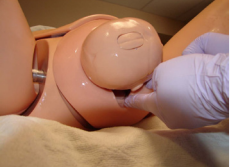
Figure 1 First perform a digital exam. Introduce your dominant second and/or third fingers from both hands along the fetus to locate the posterior shoulder and the axilla.
Hook these fingers into the fetus axilla and pull in a continuous steady force sliding upward and outward, adducting the shoulder girdle toward the fetal head and neck while passing along the maternal sacral curvature (Figure 2).
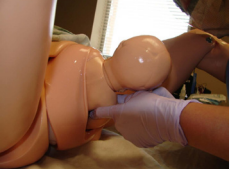
Figure 2 Once the posterior shoulder and axilla is identified, hook your fingers at the fetus axilla and pull in a continuous, steady force sliding upwards and outwards, adducting the shoulder girdle toward fetal head and neck while passing along the material sacral curvature.
If the posterior axilla is at the level of the sacral promontory, you may need to pull the axilla downwards first to release it from the sacral promontory (Figure 3) [7].
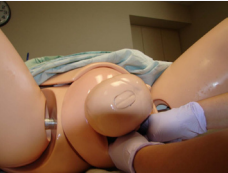
Figure 3 In severe dystocia, if the posterior shoulder was at the level of the sacral promontory you may need to pull the axilla downwards first to release from the sacral promontory, and then pull the axilla outward and upwards.
This by itself may be enough to deliver the rest of the fetus as the biacromial diameter is now smaller and a gentle assist of the fetal head can help deliver the anterior shoulder and the body afterwards. If you find that the amount of traction force applied to the axilla of the posterior shoulder is high, you may want to consider attempting the same axillary digital traction maneuver to the anterior shoulder. Start with a digital exam searching for the anterior shoulder, and then hook your fingers into the axilla (Figure 4).
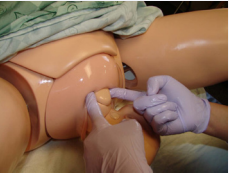
Figure 4 Anterior shoulder release, start with a digital exam searching for the anterior shoulder then hook your fingers into the axilla and pull with a continuous steady force downwards and forward, to release from the symphysis pubis while adducting the shoulder to the chest anteriorly and pulling in the direction of the head.
Pull with a continuous steady force forward and downward adducting the anterior axilla and shoulder toward the fetal anterior chest to release it from the symphysis pubis. Continue pulling in the direction of the neck and head then continue pulling until delivery of the anterior shoulder (Figure 4). After the use of the axillary digital traction maneuver to delivery the posterior shoulder, other maneuvers such as McRobert’s accompanied with suprapubic pressure alone or with Rubin I maneuver can be attempted in order to deliver the anterior shoulder. This technique was used in Case 2 where after delivery of the posterior shoulder, it was difficult to deliver the anterior shoulder with the same maneuver. Unfortunately, a short trial of McRoberts, suprapubic pressure and Rubin one also did not release the anterior shoulder. Finally the infant was rotated and with the anterior shoulder now in the posterior position, the axillary digital traction maneuver was again attempted and resulted in the successful delivery of the infant (Figure 5).
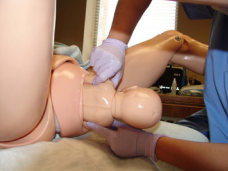
Figure 5 Both shoulders are free and delivery of the rest of the fetus continues.
DISCUSSION
The authors have been practicing the axillary digital traction maneuver for many years with good success. The axillary digital traction maneuver was first described in 1609. Bourgeois was a midwife who suggested one could resolve shoulder dystocia by digitally hooking one or both axilla with subsequent downward traction [8]. This simple maneuver remained the only expedient way to cope with shoulder dystocia for centuries [8]. Over time, other delivery methods were introduced, but axillary digital traction remained a viable option. Schramm reported routinely using the axillary traction method with good results [9]. Holman suggested that using posterior axillary traction could avoid the injury to the brachial plexus that often occurs when placing traction on the head towards the perineum to resolve shoulder dystocia [10]. Poggi et al., endorses delivering the posterior arm early in the management of shoulder dystocia [6]. Menticoglou et al., suggests using posterior axillary traction when the posterior arm is inaccessible, and extended, or lies under the fetal body [7]. Interestingly, even though the axillary digital traction maneuver has been described repeatedly in the literature over the centuries, only recently has it come up in practice guidelines. In 2013, it became a part of the ALSO taught maneuvers [11]. To date it is still not part of the ACOG or the RCOG [1,3]. The three cases presented in this report show the utility and success of the axillary digital traction maneuver. Some consideration should be given to this approach as a potential new maneuver.
New maneuvers have been reported in the last several years. Hofmeyr et al., described the posterior axillary sling traction (PAST) with using a soft plastic catheter sling around the posterior axilla with the use of traction to overcome shoulder dystocia [12]. It was suggested that this method can be used if the axillary digital traction maneuver has failed in releasing the posterior axilla. In 2011, Ansell et al., proposed an alternative to the routinely employed techniques of McRobert’s, suprapubic pressure and Rubin I maneuvers [13]. First, the position of the posterior shoulder in the Anterior-Posterior diameter (or the transverse diameter) is identified. By grasping the shoulder by with the thumb and the first finger around the axilla and placing the second finger on the tip of the humerus, one has the traction to then pull the posterior shoulder in the Anterior-Posterior diameter. The direction will follow the sacral curve and this will help the posterior shoulder deliver and the anterior shoulder to rotate away from the symphysis pubis. If the posterior shoulder is in the transverse diameter then this same maneuver will aim toward moving the axilla to the oblique diameter of the pelvis first [13]. As evident, this described maneuver is the axillary digital traction maneuver under another name.
In terms of morbidity, undefined BPI is one of the important neonatal injuries associated with shoulder dystocia. ACOG estimates that it occurs in 4 to 40% of impacted shoulders while RCOG notes the injury occurs in 4 to 16% of cases [2]. Both ACOG and RCOG Guidelines conclude that the injury is permanent in 10% of the cases [2]. RCOG notes that the injury is independent of the operator experience and both guidelines state that BPI can occur without shoulder dystocia [2]. The ACOG Practice Bulletin notes that fracture of the clavicle and humerus is possible with shoulder dystocia, as is hypoxic-ischemic encephalopathy and death [1]. Conversely, the RCOG Guideline does not mention fracture as a potential complication of impacted shoulder dystocia or the possibility of neonatal death [2]. Neither of the guidelines (ACOG or RCOG) provides the incidence of these injuries [2]. Monticoglou et al., reports that the posterior axillary traction maneuver has a drawback of potential humerus fracture with good healing rates [7]. For the mother, anal sphincter and rectal tears occur and require repair [7]. In 2011, Ansell and colleagues reported that although they had a small sample size, the degree of traction required to release the axilla, seemed to vary and depended on the degree of the shoulder dystocia. They also report that the degree of traction might be significant but unlikely to harm the baby [13]. In 2015, Cluver and Hofmeyr published a summary of 19 cases of shoulder dystocia in which the use of Posterior Axillary Sling Traction (PAST) was successful in 18 of them. Complications noted include 3 cases of hummers fracture and Erb’spalsi in 5 infants, 4 of which were transient [14,15].
In summary, ALSO, ACOG and RCOG recommend starting with McRobert’s and suprapubic pressure alone or with Rubin I Maneuvers tried first followed by the direct manipulation of the fetus [1-3,11]. For ALSO and ACOG, no single maneuver is preferred over others [1,11]. RCOG advocates McRoberts as the single most effective intervention [2,3]. Ansell et al., proposes the option of axillary traction maneuver as the first option followed by other maneuvers [13]. Maneuver alternatives and how to perform the procedure for shoulder dystocia should be incorporated into education and emergency training sessions [13,15]. In an emergency state, direct manipulation could vary from one operator to another depending on practice and experience. In the authors’ experience, the axillary traction maneuver has been overall safe and effective. By the following the technique outlined, one may do axillary digital traction to free the posterior shoulder or the anterior shoulder or both. Since the majority of shoulder dystocia cannot be predicted, standardized approaches to management have been developed but to our knowledge none of these approaches include this technique which we feel is safe, easy to perform and effective in resolving shoulder dystocia. We propose that the teaching include the digital axillary traction maneuver as another alternative for managing shoulder dystocia.
ACKNOWLEDGEMENTS
Julienne K. Kirk, PharmD for her experience in editing this manuscript.








































































































































